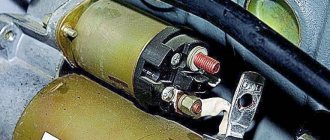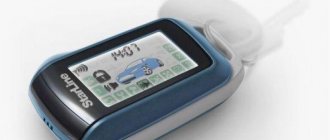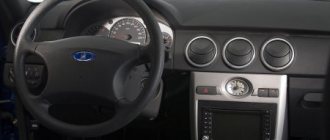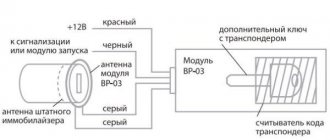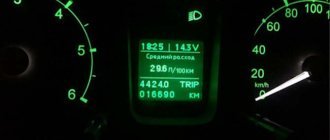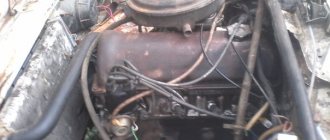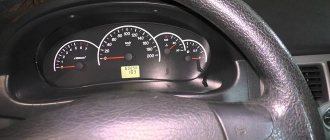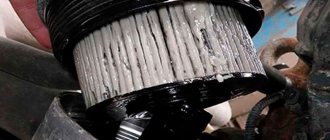The car has long become an integral part of our lives. It is quite difficult for many of us to imagine life without him. But sometimes there comes a time when the car stops starting at the most inopportune time.
Faced with such a problem, many car owners have no idea what to do in such a situation. We will try to help solve the problem when the Priora does not start and the starter does not turn the engine and what actions should be taken first.
How does a starter work?
This device is an electric motor with a gear that meshes with the engine flywheel and rotates it when started. A retractor relay is installed on the housing, which controls the movement of the gear and the automatic activation of the electric motor.
When the ignition key is turned to the start position, power is supplied to the relay and, through an electromagnet, it is drawn in, moving the gear using a special mechanism and simultaneously closing the contacts, starting the electric motor.
The moment the ignition key is released, power stops flowing to the relay magnet; it operates in the opposite direction, opening the contacts. Thus stopping the operation of the electric starter. Here is an approximate elementary diagram of the operation of the engine starting system.
How to fix problems after washing
For each situation there is a solution. If the driver used the services of a car wash, then you need to check whether water got inside the car
It is especially important to do this if the motorist has washed the engine and the car does not start. When carrying out a regular washing of the surface of the car, it is necessary to open the hood at the end of the work and check for the presence of water near the engine and other important elements
The battery, terminals, spark plugs and all wiring must be thoroughly wiped down so that moisture does not increase the amount of current drawn or drain the battery. If visiting the car wash was a fairly frequent procedure, then you need to check for gray deposits on the battery terminals. It prevents normal contact and, as a result, normal operation of the battery.
It is best to wipe the area under the hood with a soft cloth or sponge, as they absorb water best. The sponge allows you to remove moisture even in the most difficult to reach places. After wiping off the water, the car should start normally.
If the car does not start after washing the engine, this will require a more thorough inspection. First you need to inspect the spark plugs, since wet spark plugs do not produce a spark. Water under the distributor cap will also prevent the car from starting. It will need to be unscrewed and wiped completely.
Water can also accumulate in the spark plug wells, so it is better to blow them out. All wires must be inspected and, if necessary, thoroughly wiped to prevent short circuits. All this must be done before starting the engine for the first time after washing. Then you can prevent a number of problems and prevent serious breakdowns.
There are situations when, after water gets in, the car’s electronics behave strangely. This manifests itself in the fact that the car does not start when the driver has washed the engine, and the immobilizer is on. An immobilizer is an anti-theft device that, using a special program, can stop connecting electrical circuits in the most important areas.
You can avoid a flooded engine when you do not use a high-pressure car wash. It is these devices that drive water inside the motor, which prevents its normal operation. It is best to wash the engine by hand, the old-fashioned way, and clean hard-to-reach areas with a brush. This will take more time, but will not cause problems with starting the car.
Where to start if the starter does not turn and the Priora does not start after several attempts
If the relay makes a clicking sound when you turn the key:
- at the same time, the lights on the dashboard go out;
- it is necessary to check the battery charge;
If the battery is ok:
- after several attempts to start the car, touch the wires coming from the battery; when they heat up, you need to check the contact between them and the battery;
- remove the terminals from the battery and clean them;
- reinstall the terminals;
- check the connection of the ground terminal to the body, if necessary, clean the connection;
- check the connection of the positive terminal with the contact on the starter;
- it is necessary to check whether power is supplied to the relay from the ignition switch; to do this, disconnect the connector from the solenoid relay;
- turning the ignition key to the “start” position, use a tester to measure the voltage at the connector;
Priora takes a long time to start when cold
Every morning there is such a problem as in the video
https://youtube.com/watch?v=HrA0cLgVQEk
I’m sure this is not normal, since everything is a bunch when it’s hot, and I tried starting it cold with friends out of curiosity. When I pulled out the spark plugs that were there, there was a light white coating. I took the car in for cleaning of the injector, throttle, etc., and it didn’t feel much better than in the video. (it was worse) I changed the spark plugs to Denso QP20, the situation has not changed. The speed does not fluctuate, the engine runs smoothly.
Or take it to the dealer? But it seems to me they will start to pile on))))
Greetings to everyone :) I solved the problem with the knocking, and largely thanks to you! Guys, we need to solve the 2nd issue - it doesn’t start well when cold. The car is a Priora 16 valves. After a night of sitting idle, you start it in the morning and it seems to catch on, then it immediately starts to cackle. And so on several times. then it started but stalled! Sales don’t triple, they double! Errors pop up 0300 0301 0304. It smells like gasoline. I changed the spark plugs en masse, 4 of them, but it didn't help. I swapped the coils - it didn't help. I bought a reel and installed it one by one, but it didn’t help. I went to the diagnostician - he looked and found nothing, he said come to me in advance and cool the car. The diagnostician says the ignition is clearly in phases, the fuel pressure is normal.
Comments 45
Today I installed a new IAC KZTA. Let the car cool down in the wind - I’ll go in the evening and we’ll see.
Once upon a time, a long time ago, there were problems with the Avtel ECU. As long as it's warm it starts without problems. But as soon as it gets cold, that’s it. People simply changed the ECU to something else and the problem went away. You can also try in the morning, when the car starts making horns, pull out the ECU, open it and heat the board from below with a miniature gas burner. Yes, you can even use a lighter. As a rule, this helped. By the way, what kind of ECU?
Bosch ECU. I don’t remember which one exactly
Write when you find the answer. And what did you find about the knocking?, but at -10 I had such nonsense in the morning. As it got warmer everything became fine, but Nati managed to figure out what was wrong. I think by winter we will start looking for an answer again.
I think the O-rings on the injectors are leaking air and the mixture becomes lean)
on the engineer nine, the coolant temperature sensor always showed that it was very cold, this made the mixture rich in the stench of gasoline, etc., it started very poorly, and then until it slammed into the muffler. Idk guys, but as an option.
I agree, it could very well be a temperature sensor, but this should have come up during diagnostics. Maybe the specialist is not entirely competent?
My check never showed, but according to the parameters it worked but gave the wrong readings, sometimes on the on-board vehicle it just showed 0 intermittently
No friend will do this, you have more questions than solutions. You also need to make some kind of contribution to the community, otherwise interest in your person will quickly disappear) You worked on your head for half a month, intrigued everyone, and now (I solved the problem with the knock) and that’s it? For general development, you can tell us, maybe with a photo for clarity, what was knocking, how it was eliminated, so that in the future we will know the reason causing such a specific sound.
Any car has a very complex device and one small failure is enough for problems to start. For example, many car owners may notice that over time the engine of their Lada Priora starts worse, stalls, or stalls. The situation becomes especially complicated if the car cannot start when cold, because in this case any attempt to use the car will turn into a real test of nerves.
Nothing ever happens to a car for nothing. If you notice that your Priora does not want to work, then there are objective reasons for this. Your task in this case is to find the problem and fix it. Typical malfunctions in which the Lada Priora starts poorly or does not start at all when cold are completely remediable in a garage (with the exception of engine failure). They are similar for engines 1.5 and 1.6, with 8 and 16 valves. Today we’ll talk about why a car may have difficulty starting when cold, when hot, or stall immediately after activating the engine.
Removing the starter
- disconnect the terminals from the battery;
- unscrew the air filter and remove it;
- Unscrew and remove the positive wire from the starter terminal;
- disconnect the connector from the relay;
- unscrew the starter mounting nuts and remove it;
Checking the relay operation
Using emergency wires for “lighting up”, connect the negative wire from the battery to the electric starter housing. Connect the positive one to the relay connector, and it should operate and throw the gear forward. If the result is negative, the relay must be changed.
Checking the operation of the electric motor
By hooking the negative wire to the electric starter housing, and the positive wire to the lower terminal of the retractor relay. The electric motor should start working. If this does not happen, then most likely the motor brushes need to be replaced.
Having examined the reasons why the starter does not turn and the Priora car does not start, we can conclude that the electric starter itself may not always be the cause of the problem. Most often these are bad contacts in the system connections or simply a broken wire.
But if the reason is still in the starter, do not rush to buy a new one. Many faulty parts can be replaced by simple overhaul, saving money. And the old starter will last for a long time.
We often hear complaints from vehicle owners that the starter does not respond to turning the ignition key. This situation is typical for the cold season, but can also happen in the summer. Its unpredictability lies in the fact that it is impossible to predict exactly when the car will start, and whether it will start at all. In any case, there is no reason to panic, since such a problem is easily fixed.
Main reasons and ways to solve them
Lada Priora 16 valves is a car created on the basis of innovative technologies borrowed from foreign concerns, so the technical side provides different functionality. Another important property is that all parts are original, so if necessary, the consumer can easily carry out repair work.
The reasons why a car does not start may differ depending on external influences, namely the lack of starting torque in cold weather, due to technical problems, and so on.
Starter failures and their solutions
If the starter does not turn and the car engine does not start, then the following breakdowns and ways to eliminate them can be identified.
| Suspected malfunction | Diagnostic method | Elimination method |
| No battery charge | The rated voltage at the battery terminals without load must be at least 12V. If the engine does not start, a characteristic clicking and crackling sound is created. | Charging the battery or replacing it completely. |
| Terminals are oxidized or loosely installed | When starting the engine, the rated voltage drops several times more than at the battery terminal. When the system operates, a characteristic cracking sound is created. | You can clean the contacts and treat them with special means to restore the accuracy of the connection. |
| Engine wedge | Check the rotation level of the crankshaft and generator system pulley. | Restore the operation of the engine, pump or generator system. |
| Starter malfunction | Carry out a technical inspection of the starter. | Repair it or replace it with a new one. |
| Faulty starter circuit | When turning the starting key to position “II”, the starter traction relay does not operate. The voltage supply level is checked. | Replace the starter relay, wires or ignition key depending on the location of the damage. |
| Traction relay malfunction | When starting with the key in position “II”, the relay does not operate, but the required voltage is supplied. The relay is removed and inspected for damage. | The traction relay is replaced, since in most cases they cannot be repaired. |
| Oxidation of contacts or incorrect operation of the “mass” | When the starter starts, a characteristic click is created, and the starter armature does not rotate, which leads to jamming of the entire system. The contacts leading to the starter and the ground terminals are checked. | All terminals must be lifted, the contacts must be cleaned of oxidation and, if necessary, the damaged section of the wiring must be replaced. |
| System break in traction relay | When starting the engine, a characteristic cracking sound is created, and the voltage from the battery is provided at a normal level. | The traction relay is being replaced. |
| Towing the clutch at idle | When the starter is turned on, the armature rotates, but the flywheel remains stationary. | The clutch or the entire starter is replaced if it is impossible to carry out repairs. |
As a rule, a detailed examination of the starter system and related structures provides an opportunity to identify the problem and efficiently eliminate it. Sometimes the malfunction is a combination of several breakdowns, for example, the battery is discharged and the terminals have come loose. Therefore, it is important to pay close attention to all the details.
The starter works, but the engine does not start
If the starter turns for a long time, but the engine does not start, or the car does not start well without gas, then in this case we can talk about the presence of malfunctions on the part of the motor or in the circuit leading to the starter. And sometimes the reasons are more primitive: lack of fuel, battery discharge, broken connections or their deviation from the established places. Careful consideration of the causes of such a malfunction, methods of diagnosis and elimination allows you to achieve the goal in terms of restoring functionality.
| Suspected malfunction | Diagnostic method | Elimination method |
| Lack of fuel in the tank | On the instrument panel, the fuel gauge shows zero marks. | Fill the gas tank. |
| Low battery | Lack of rated voltage without battery load, which creates a characteristic crackling sound. | You just need to charge the battery or, if it is completely faulty, replace it with a new one. |
| Terminals are oxidized or loosely fastened | Lack of proper voltage and the appearance of an extraneous crackling sound when trying to start the engine. | The terminals and wires are cleaned and treated with technical lubricants to prevent short circuits. |
| Violation of the phase of the gas distribution element | You need to carefully check the marks on the crankshaft and camshaft pulley system. | The shafts are installed in the correct position. |
| Failure in the ignition system | The system is checked for the presence of a spark, from which the engine starts. | The ignition circuits and systems are checked, and the necessary elements in the system are completely replaced. |
| The fuse overheats and the main relay in the system does not function properly | Check the relay and fuse for damage. | The cause of the fuse blown is eliminated. And if necessary, replace the relay or the fuse itself. |
| Insufficient pressure in the fuel system | The pressure in the fuel system is checked for deviations from the norm and the condition of the fuel system. | The filter is cleaned, the fuel pressure is adjusted and the fuel pump is replaced if necessary. |
| Malfunctioning injectors and circuits | 1). It happens that the fuel pump turns and pumps fuel, but the car does not start. Using an ohmmeter, the quality of the injector windings is checked. Circuits are also diagnosed for breaks. | 1). Injectors or chain parts are completely replaced. |
| 2). The fuel pump does not pump. | 2). The fuel pump is checked for damage and functionality. |
As a rule, owners of a Lada Priora, both cold and hot, most often encounter a break or damage to the system leading from the starter to the engine, so the engine does not seize and does not start. This will eliminate the problem without spreading it in the form of breakdown of additional elements.
We recommend: Reasons for increased fuel consumption
Reasons for starting and subsequent engine shutdown
It often happens that the engine starts and then stalls after a few seconds, so it is important to highlight the main causes of such a malfunction:
- The connections of the electrical coils, which are responsible for quickly starting the engine, become loose or damaged.
- There is no proper pressure in the fuel system.
- Leaky connections in the line also cause engine malfunction.
Automotive experts recommend regular vehicle maintenance to avoid future breakdowns. But if it was not possible to prevent the occurrence of malfunctions, then in this case it is recommended to contact highly qualified specialists at a service station who will be able to restore the functionality of the car.
Why is there no sound from the starter when I turn the key?
The design of the starter of any vehicle is a powerful electric motor, the power source of which is a car battery. Such an element is characterized by both mechanical damage caused by improper operation and natural wear of its component parts, as well as malfunctions associated with its electrical part. When no changes occur in the starting system of the power unit after turning the ignition key, the starter is silent, and its retractor relay does not make characteristic clicks, the following diagnostic measures must be carried out:
- Measure the power supply voltage
- Check the condition of the contacts in the ignition switch
- Perform a performance test on the solenoid relay
- Carry out diagnostics of the starter and its bendix
Fuel system
Problems here also very often prevent the car from starting when cold. First of all, you need to check whether there is the necessary pressure directly in the fuel rail. The pressure gauge is connected to the fitting installed on it. When, after turning on the ignition, it does not increase, then most likely the following has failed:
- gasoline pump;
- relay controlling it;
- fuses have blown.
You can simply verify that the unit is working – just listen in the cabin. If the pump starts, a characteristic sound will be heard from the rear seats.
After this, you will have to find out whether the suction pipe in the fuel tank is clogged and whether fuel passes through all the hoses.
Often, poor starting is due to the quality of the gasoline being poured being too low. It may, in particular, contain water or other foreign impurities.
It is important to pay special attention to the following point - if the injectors are working, clicks will be heard. If they are absent, you need to check the voltage in the on-board network and the presence of ground. It should also not be ruled out that the problem lies in the ECU or power relay.
It is worth checking whether the candles are wet. This happens quite often after the power plant has overheated. In this case, they are removed from the nests and examined. Quite often, simply wiping them dry is sufficient.
In the end, I would like to say one thing - in order for the car to continue to work without failures in the future, you only need to regularly care for it, carry out preventive maintenance and promptly prepare it for the winter period.
Several other reasons why the starter is silent
The reason that the starter does not respond to turning the ignition key may be incorrect operation of the vehicle's anti-theft systems (immobilizer or alarm). The thing is that these modules turn off the voltage supply to the starter terminals. At the same time, during the diagnostic process, it is not possible to detect any significant problems in the operation of the main components of the vehicle. Such a problem can only be detected by directly applying voltage from the power source to the starter terminals. If everything is fine with it, therefore, the cause of the breakdown is a malfunction of the immobilizer or security system.
The next step is to test the solenoid relay. If it breaks down, the starter behaves as follows:
- does not respond when trying to start the power unit;
- makes characteristic sounds and scrolls, but its power is not enough to start the engine;
- makes clicking noises, but does not turn the engine crankshaft.
Such symptoms indicate damage to the bendix, as a result of which it cannot be united normally with the flywheel and scrolls, as well as a malfunction of the solenoid relay. If the bendix fails, then a metallic crunch is heard in the area of the engine compartment, while the engine crankshaft remains motionless.
To check the retractor, you need to apply voltage to it from the battery by connecting the “plus” of the battery to the power terminal, and the “minus” to the housing. If the starter motor begins to rotate, then the traction relay is faulty. Often the cause of such a malfunction is the burning of the contact coins and is completely eliminated after cleaning them. True, this measure is temporary, and after it you will still have to replace the relay, since the nickels are coated with a special non-stick coating, which is completely destroyed during cleaning.
Generator
When this element operates correctly, it produces a voltage within 14 V, provided that the engine is idling and the vehicle's electrical system is not loaded.
The first start increases the voltage by 2 V. Then it stabilizes to the correct values. They are also affected by:
- battery status;
- load;
- air temperature.
Problems with the generator are often the reason why the engine will not start. During frosts, the voltage can vary from minimum values (12.9) to maximum values - 14.8 V.
After this, the 16-valve Priora should check its generator. It is easy to check its operation by connecting the power supply directly, bypassing the regulator. If overvoltage is detected, replace the latter relay.
Mechanical and electrical problems
The engine starter may not work due to wear out of the bearings located at the front and rear of the engine. Their function is to ensure smooth acceleration of the starter shaft. If they are worn out, the retractor will make clicks, and the crankshaft of the power unit will remain motionless. The reasons for this problem are:
- imbalance of the starter shaft;
- burning or short circuit of winding turns.
Note that this may cause a short circuit in the vehicle's electrical circuit, which may cause a fire. If the starter does not respond to turning the ignition key, you cannot force it to work for a long time. It is best to make several short starts of the engine.
Since the design of the vehicle’s power unit starting device is based on an electric motor, the voltage necessary to increase the speed of its shaft is supplied to the winding through graphite brushes. The material they are made of does not have sufficient strength, these elements wear out quickly.
Ignition
According to experts, ignition failures often occur in Prioria. The functionality of this system is relatively easy to verify. This is done by checking the presence of the spark plugs. If there is no spark, it is possible that:
- The ignition device is damaged;
- The crankshaft and distributor sensors are not working properly.
For a complete diagnosis, you should visit a car repair shop. Special devices are used here, with the help of which it is easy to determine which element has a problem.
If there is no spark at the spark plugs, we can say with a high degree of certainty that there is a malfunction:
- ignition device;
- his coils.
Summarizing
It is advisable that the starter spins the engine crankshaft during an attempt to start it for no more than 10 seconds, then the device must be given a minute pause. Failure to comply with this rule will, at best, lead to a discharge of the power source, and at worst, it will completely disable the starter. Only replacing it can save the situation, since not every auto electrician will undertake the task of rewinding burnt windings, since it is not always possible to perform this procedure efficiently. In addition, the cost of this service is comparable to the cost of a new element.
When I turn the ignition key, the car does not start. You can hear clicks and sometimes crunching sounds. You turn the key a few times and the car starts.
Today, when I turned the key, the lights on the instrument panel came on, but the starter did not react at all.
The battery terminals are secure and the battery is new. The starter was disassembled, washed and checked by closing the contacts. No deviations were found. Bosch starter
Main reasons and ways to solve them
Lada Priora 16 valves is a car created on the basis of innovative technologies borrowed from foreign concerns, so the technical side provides different functionality. Another important property is that all parts are original, so if necessary, the consumer can easily carry out repair work.
The reasons why a car does not start may differ depending on external influences, namely the lack of starting torque in cold weather, due to technical problems, and so on.
Starter failures and their solutions
If the starter does not turn and the car engine does not start, then the following breakdowns and ways to eliminate them can be identified.
| Suspected malfunction | Diagnostic method | Elimination method |
| No battery charge | The rated voltage at the battery terminals without load must be at least 12V. If the engine does not start, a characteristic clicking and crackling sound is created. | Charging the battery or replacing it completely. |
| Terminals are oxidized or loosely installed | When starting the engine, the rated voltage drops several times more than at the battery terminal. When the system operates, a characteristic cracking sound is created. | You can clean the contacts and treat them with special means to restore the accuracy of the connection. |
| Engine wedge | Check the rotation level of the crankshaft and generator system pulley. | Restore the operation of the engine, pump or generator system. |
| Starter malfunction | Carry out a technical inspection of the starter. | Repair it or replace it with a new one. |
| Faulty starter circuit | When turning the starting key to position “II”, the starter traction relay does not operate. The voltage supply level is checked. | Replace the starter relay, wires or ignition key depending on the location of the damage. |
| Traction relay malfunction | When starting with the key in position “II”, the relay does not operate, but the required voltage is supplied. The relay is removed and inspected for damage. | The traction relay is replaced, since in most cases they cannot be repaired. |
| Oxidation of contacts or incorrect operation of the “mass” | When the starter starts, a characteristic click is created, and the starter armature does not rotate, which leads to jamming of the entire system. The contacts leading to the starter and the ground terminals are checked. | All terminals must be lifted, the contacts must be cleaned of oxidation and, if necessary, the damaged section of the wiring must be replaced. |
| System break in traction relay | When starting the engine, a characteristic cracking sound is created, and the voltage from the battery is provided at a normal level. | The traction relay is being replaced. |
| Towing the clutch at idle | When the starter is turned on, the armature rotates, but the flywheel remains stationary. | The clutch or the entire starter is replaced if it is impossible to carry out repairs. |
As a rule, a detailed examination of the starter system and related structures provides an opportunity to identify the problem and efficiently eliminate it. Sometimes the malfunction is a combination of several breakdowns, for example, the battery is discharged and the terminals have come loose. Therefore, it is important to pay close attention to all the details.
The starter works, but the engine does not start
If the starter turns for a long time, but the engine does not start, or the car does not start well without gas, then in this case we can talk about the presence of malfunctions on the part of the motor or in the circuit leading to the starter. And sometimes the reasons are more primitive: lack of fuel, battery discharge, broken connections or their deviation from the established places. Careful consideration of the causes of such a malfunction, methods of diagnosis and elimination allows you to achieve the goal in terms of restoring functionality.
| Suspected malfunction | Diagnostic method | Elimination method |
| Lack of fuel in the tank | On the instrument panel, the fuel gauge shows zero marks. | Fill the gas tank. |
| Low battery | Lack of rated voltage without battery load, which creates a characteristic crackling sound. | You just need to charge the battery or, if it is completely faulty, replace it with a new one. |
| Terminals are oxidized or loosely fastened | Lack of proper voltage and the appearance of an extraneous crackling sound when trying to start the engine. | The terminals and wires are cleaned and treated with technical lubricants to prevent short circuits. |
| Violation of the phase of the gas distribution element | You need to carefully check the marks on the crankshaft and camshaft pulley system. | The shafts are installed in the correct position. |
| Failure in the ignition system | The system is checked for the presence of a spark, from which the engine starts. | The ignition circuits and systems are checked, and the necessary elements in the system are completely replaced. |
| The fuse overheats and the main relay in the system does not function properly | Check the relay and fuse for damage. | The cause of the fuse blown is eliminated. And if necessary, replace the relay or the fuse itself. |
| Insufficient pressure in the fuel system | The pressure in the fuel system is checked for deviations from the norm and the condition of the fuel system. | The filter is cleaned, the fuel pressure is adjusted and the fuel pump is replaced if necessary. |
| Malfunctioning injectors and circuits | 1). It happens that the fuel pump turns and pumps fuel, but the car does not start. Using an ohmmeter, the quality of the injector windings is checked. Circuits are also diagnosed for breaks. | 1). Injectors or chain parts are completely replaced. |
| 2). The fuel pump does not pump. | 2). The fuel pump is checked for damage and functionality. |
We recommend: Error codes for Lada Kalina: self-diagnosis of the on-board computer and decoding
As a rule, owners of a Lada Priora, both cold and hot, most often encounter a break or damage to the system leading from the starter to the engine, so the engine does not seize and does not start. This will eliminate the problem without spreading it in the form of breakdown of additional elements.
Reasons for starting and subsequent engine shutdown
It often happens that the engine starts and then stalls after a few seconds, so it is important to highlight the main causes of such a malfunction:
- The connections of the electrical coils, which are responsible for quickly starting the engine, become loose or damaged.
- There is no proper pressure in the fuel system.
- Leaky connections in the line also cause engine malfunction.
Automotive experts recommend regular vehicle maintenance to avoid future breakdowns. But if it was not possible to prevent the occurrence of malfunctions, then in this case it is recommended to contact highly qualified specialists at a service station who will be able to restore the functionality of the car.
The starter turns, but the Priora does not start - this is one of the most pressing issues. A person may begin to panic when such trouble occurs, but in fact there is no need to despair. In some cases, the reasons may be quite insignificant. Knowing what can lead to this kind of problem, you can protect yourself from it or easily eliminate it if it occurs.
Main reasons
So, a man finds himself in an unpleasant situation when the starter of his Priora spins, but the engine does not start. There could be a whole bunch of reasons for this. It’s worth talking about them in more detail.
- 1. The fuse has blown. In this case, you will need to check its integrity. To do this, you can use a special indicator in the form of a screwdriver or a tester. If these tools are not at hand, you will have to wait for help from passing drivers;
- 2. The terminals on the battery have oxidized or it is simply discharged. This seemingly typical car malfunction can serve as another reason. , then he will be able to turn the starter, but there will not be enough charge for the engine. It is worth checking the device to rule out this possibility;
- 3. Defective ignition switch;
- 4. Corrosion. It can appear on any electrical part of the Priora. First of all, it is worth checking the starter itself, because it is always open to the flow of moist air, and this is the main cause of oxidation;
- 5. . This can also be checked by calling. For these purposes you will need a tester. If this part is faulty, it must be replaced.
- 6. Accumulation of condensate under the hood of the Priora;
- 7. Problems with the fuel supply system. This is very common in this kind of trouble. There are a whole bunch of devices that are responsible for the smooth operation of the system. It is not always possible to fix the problem yourself, so it is better to turn to professionals;
- 8. . And this problem can arise for every car enthusiast. In this case, it is imperative to use a candle holder, and then check their performance. Sometimes just wiping them is enough, but sometimes they may need to be replaced. It is better to carry them in the trunk for this occasion;
- 9. Engine overheating. This is another nuisance that can lead to the car's operation being suspended. There could be many reasons for this. For example, it may simply happen. There are many tubes coming out of it, so each of them may be faulty. , which is responsible for starting the engine, can also make it impossible to start it. There is only one piece of advice here - immediate replacement of the unit. There is so-called internal overheating, which is much worse than external overheating. While all sensors will definitely report the second option, the second option is practically indeterminable. You need to immediately contact the service for help.
The starter does not turn or turns slowly
It happens that it does not and the starter does not rotate at all or rotates very slowly. In this case, it is recommended to focus on the element circuit. For quick diagnostics, turn on the headlights and observe what happens when the driver starts the engine. If the headlights begin to go out, this may indicate oxidized contacts of the traction relay and ground. In this case, it is recommended to carefully check the contacts.
The engine stops while running - reasons
1. Poor quality fuel is the first thing that comes to mind for most of us, and besides, this is where we need to start looking for the reason for the engine stopping while driving. You will be “lucky” if this happens immediately after refueling, in which case you can confidently say that the problem is in the fuel. Treated by draining the fuel and replacing the fuel filter.
2. Candles. As a rule, suspicion most often falls on them, after bad fuel, of course. Everything is simple here - unscrew the spark plugs and check their condition, replace the spark plugs if necessary.
3. Fuel filter. A seriously clogged filter can cause an interruption in fuel supply, causing you to rev the gas and the engine to stall while driving. To eliminate the problem, simply replace the fuel filter.
Problems launching Priora: checking system operation
If, after performing basic research, the car starter turns and the Priora , then you should look for the reasons in other control systems. For example, malfunctioning ECU or coolant sensor may make it impossible to start the power unit.
Such problems are solved at a service station, and the driver will have to call a tow truck to send the car to specialists. This solution is also acceptable in the case when the crankshaft position sensor has stopped working normally.
A broken timing belt or shearing of its teeth will result in expensive repairs, so the element should be replaced as soon as possible. Problems with the crankshaft may be associated with individual components of the cylinder-piston group, the generator wedge or the coolant pump.
If the engine refuses to work in extreme cold conditions, the engine oil may simply have frozen. Correct operation of the car is ensured only if the substance used is completely changed to that recommended by the manufacturer.
A dirty fuel filter or damaged fuel line will also affect engine performance. In this case, the starter will work normally, but the engine will not be able to start.
First of all, you will need to clean the filter, because in some cases the pressure in the rail will be insufficient to start the unit. If the reason is damage to the fuel line or the filter itself, then they will need to be completely replaced.
Another reason could be a blown fuse or relay of the control system or idle speed regulator. In the first case, you will need to study the fuse and, if necessary, install a new one. If, after starting, the engine stalls after releasing the gas pedal, then the idle speed sensor needs to be replaced. All procedures are usually carried out at a service station.
In any of the situations described, the Priora must be repaired immediately. Even if the launch was successful after several attempts, similar problems should not be ruled out in the future.
Why the car behaves this way and what exactly was the root cause are the main questions that need to be resolved. If the check does not help and the cause of the breakdown is not found, you should contact a car repair shop and have all transport systems diagnosed.
Priora is a car that is quite popular among Russian drivers. Many note that the mentioned machine is very reliable and easy to operate. However, problems sometimes occur with it too.
Very often the following happens - Priora does not start, and yet its starter still turns. Such troubles are noted by owners of both new cars and those that have been in use for some time.
In reality, there are many reasons why the Priora engine does not want to start. The most common ones are discussed in the article below. Such information will undoubtedly be very useful to owners with little experience.
Lada Priora won't start. What's the problem?
Repair and replacement of the engine start switch
The ignition switch of the Lada Priora is an electromechanical device consisting of a contact group and electrical communications. This engine starting system component wears out when the tracks are switched on and off repeatedly. When they are mechanically damaged, current conductivity deteriorates, resistance and temperature in the contact area increase, which leads to their burning. Another reason for ignition switch failure is the breakdown of plastic parts.
Malfunctions associated with problems with electrical connectors arise due to overload of the contact group caused by the connection of additional high-power devices. Another problem is short circuit. On the latest car models, modified designs are installed that have a more reliable contact group. If these defects are detected, the Priora ignition switch with immobilizer assembly will need to be replaced.
First you need to disconnect the negative battery terminal, then remove the plastic steering column cover, the electrical connector of the main wiring harness and the instrument mode switch. The next step is the most difficult: you need to remove the screws securing the lock to the steering column. They have round tear-off caps that provide an additional degree of security for access to the ignition switch. For this reason, they should be unscrewed carefully, using a special sharp chisel, lightly tapping it with a hammer. It is enough to make one turn of the screw to be able to unscrew it by hand. By unscrewing all four fasteners, you can remove the lock fixing bracket. The final stage is to disconnect the plug of the contact group. After replacement, installation of the removed parts is carried out in the reverse order.
20.03.2014
Words "Winter"
and
“Won’t start”
are always next to each other, because this time of year is a good test of the technical condition of the car.
This is on the one hand. On the other hand, winter helps some drivers get rid of greed and stop buying gasoline for their car at a ridiculous and low price - as in our case with the Lada Priora car.
In the photo the car is already in the process of being repaired.
First, the car went to our electricians and electronics engineers; for some reason people always think that if the car doesn’t start, then the electronics are primarily to blame. But as it turned out, these deep and complex technical areas had nothing to do with it: our colleagues, after carrying out their checks, measured the compression and waved to us (we work in the same workshop): - Guys, this is your car, there is no compression here!
By the way, it’s very convenient when mechanics, electricians, and electronics engineers work in the same repair bay: if something doesn’t work out for us or if we have any questions, we go to them. If they have questions about the mechanical part, they turn to us.
We started checking. There is no compression in the first and fourth cylinders. And then lunch time came - we had lunch, and then decided to try again to start the engine. And then, lo and behold, the car started right away. With “half a kick”, as they say. We looked at each other and didn’t understand anything yet; the further you go, the more interesting it gets? There was no compression, but the car sat a little warm and it started. And compression appeared like out of a fairy tale.
The partner asked: “Have you come across this?” I shrugged: “It’s not clear yet, but I have some thoughts.”
We wanted to see the picture inside the cylinders with a videoscope, but it didn’t work out. Conducted other checks. Since we’ve been working with Sergei for a long time (he’s my partner), we didn’t explain much to each other: “Does it look like gasoline?” - Yes, there seems to be such a problem...
That’s why we decided to remove the “head” and see what and how.
Are you surprised? What does “gasoline” and “remove the head” have to do with it, that is, the cylinder head?
You know, we have come across, and even quite recently, cars in which the problem of winter non-starting in the morning was gasoline: KIA Rio 2011. Fresh, as they say. The only problem is: “it won’t start.” It was the beginning of 2013 and then the frosts were not very severe, but they were enough to prevent the car from starting in the morning.
The client told us wonderful things: our car service was already the fourth in a row. In the first, he was given a starter - and changed. At the second car service they found a fault in the fuel pump and also replaced it. The client didn’t talk about the third one, he just waved his hand.
And what’s most amazing is that after replacing the starter, fuel pump and something else, the car started up so cheerfully, the specialists smiled contentedly and saw the client off, warming the money they received in their hands. And then the car sat on the street overnight, froze until the morning and then the usual: “It won’t start.”
We checked the compression of this Kia - there is no compression. Then they also looked at each other: “Gasoline?”, “Yes, it looks like that...”.
But we tried to make do with little expense: we put the engine on intensive flushing and this helped - the car began to start with half a kick.
Well, here, on this Lada Priora, after an examination, we decided that the disease had gone too far, it needed to be treated surgically - remove the “head” and have a look.
Removed. We looked. We pulled out the valves - we could barely pull them out, because they could barely move in the guides. They really “teared out” the valves, helping themselves with kind Russian words.
We put everything back together, started the engine - it started as soon as it saw the key. Everything is fine. They took it out into the cold, and the frost got worse that day; in the evening they started it up and the start-up was normal again. The car was given to the client. He rode for several hours, then called: “Heaven and earth! - he said - I hardly press the pedal, it goes by itself!
Well, we didn’t celebrate the victory - there was a reason: when the client came to pick up the car, we told him that “we definitely need to change the gasoline in the tank. Necessarily!". To which the client was very surprised, became agitated and categorically refused to do this. That’s why we didn’t celebrate the victory, we waited and... in the morning we waited: the client called and said in a depressed voice: “The same thing again.”
Of course, this is not our fault at all - we strongly recommended that the client replace the gasoline in the tank, but he refused. It's hard to say why. The euphoria of a machine running again, maybe...
But they hoped for the best: in the morning, when the client brought the car, they measured the compression again. Not happy: there is no compression in any of the cylinders. Complete zero. But we didn’t lose hope yet, we hoped that the problem was not too big, this could happen due to low-quality fuel, water in the tank, plus frost. Hence the ice and wedge on the valves. They put it in a warm place, hoping that if it was water, it would warm up.
But no luck, it didn’t warm up, so I had to start all over again: removing the head, studying the problem, which turned out to be much more serious than it was: all the intake valves were bent, and the third valve soured to such an extent that it got stuck in the guide and had to be torn out along with guide.
These are the parts of the valve drive mechanism: 1 – valve; 2 – guide sleeve; 3 – retaining ring; 4 – oil deflector cap; 5 – spring support washer; 6 – internal spring; 7 – outer spring; 8 – spring plate; 9 – crackers; 10 – adjusting washer; 11 – pusher.
Valve guides have two functions: dissipating heat from the valves and calibrating the valve seat.
What we got: valve 1 was firmly glued into guide sleeve 2 and would not come out without it. This is what we had to “rip out” - together. The story of completely disassembling and putting the cylinder head in order repeated itself.
Everything new was replaced and installed.
Now it's time to show the cause of the problem: the valve at close range, where deposits are clearly visible. The valve only worked for 3 hours since it is new.
The cause of all troubles and troubles is visible on the valve - deposits. And this is a already washed valve, they cleaned it for an experiment to understand what kind of composition was inside that old gasoline.
They washed it, but they didn’t wash it, if you handle it with your hands, your fingers stick like good glue and then it’s difficult to wash your fingers even with gasoline. When it was warm, this compound on the valves became a little plastic and allowed the valves to move in the guides. And as soon as the temperature dropped lower, the deposits solidified and, better than cosmic superglue, tightly clamped the valve stem into the guide.
What's next? The fuel tank will most likely have to be replaced, because it is unlikely that it will be possible to wash it of that old gasoline. Well, the fuel lines will have to be washed very thoroughly and more than once. Or change?
Our client refueled in the Moscow region. “What kind of gas station is this?” we asked and heard in response that “at that gas station there are very good discounts on gasoline: when you buy a card for regular service, the discount per liter can reach about 60 kopecks.”
Truly: “the miser pays twice.”
Trusov A.M. © Legion-Avtodata
Trusov Andrey Mikhailovich
Elektrostal (Moscow region), Mira Avenue, 27-a
Autotech
Engine problems can appear suddenly. The same “check” that is displayed on the dashboard at the most inconvenient moment forces a person to immediately schedule the nearest diagnostics and repairs. Find out from the article why the Priora starts and stalls - there are three reasons for this, the first is, of course. Fuel delivery problems can be scary when you try to start the car, but everything is fine. There is also a problem with the fuel system, or rather with its regulator, when the Priora is just as difficult to start when hot, although there is also a sensor involved. In general, in this article I have collected for you the main breakdowns why the car will not start - let's go!
How to solve the problem and start the engine?
How to start a car if the starter is faulty?
There are several options to solve the problem:
- The most common is to start the engine using a pushrod. The car must be pushed until it can reach a certain speed required to take off, preferably in third or second gear. Only a car with an automatic transmission cannot be started from a pusher.
- Try closing the starter. To do this you will need a screwdriver as well as a wrench. The size of the key must be selected in accordance with the distance between the relay terminals - they will need to be closed. The gearbox selector is set to neutral, the brake pedal is pressed, and the key must be in the required position.
- As a rule, the starter simply has to be repaired, but as practice shows, this mechanism can rarely be repaired. It would be advisable to make repairs if the bendix or relay fails. If the malfunction affects the electrical system, the device will need to be replaced.


